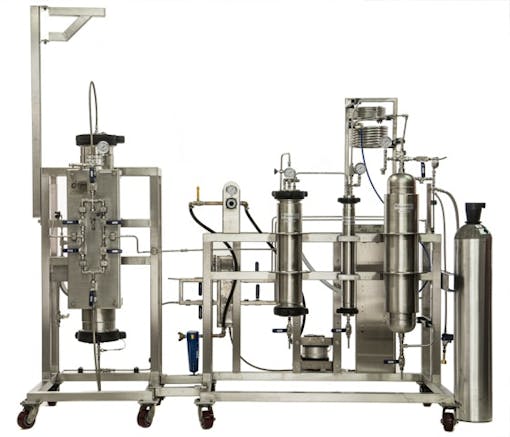The concentrate landscape is evolving, an exiting revelation considering how rudimentary dabbing implements are often seen as the black sheep within the cannabis industry, affecting regulatory action and cultural acceptance. This distinction was just recently reaffirmed by Oregon’s legalization, which excludes concentrates from its recreational cannabis implementation plans.
Because of these product restrictions, we’re seeing technological development drive product safety, quality, and usability, stabilizing its foothold in both recreational and medical markets.
Safe Products Are Clean

A CO2 extraction system from Eden Labs
Extraction methods make up the core of the concentrate revolution. This includes the science behind the method, as well as the ability to execute. For example, butane, the most prevalent method today, receives a bad rep for its propensity for danger, not the theory behind the process. AC Braddock of Eden Labs, which specializes in CO2 extraction equipment, further elucidates this point:
“There’s nothing wrong with [butane] but it’s on an industrial, commercial, professional level. You have to have the equipment and the education to make sure there’s nothing left in there, as well as an explosion-proof facility and all the safety features for the people operating it. Because it’s so inexpensive to create, it creates a green market. Fast isn’t always best. Easy isn’t always best. Things that are better take more time and more effort.”
Consumer demand and elevated industry safety standards are driving a push for clean products, beginning with safety and ending with taste. Clean products are most assuredly achieved through the cleanest processes, pushing growth towards solventless craftsmanship like CO2 and H2O extraction. CO2 extraction is quickly gaining market share due to its quality assurance, which Braddock speaks on:
“In the nutraceutical world, they started using CO2 as a marketing tool. As a consumer, if you’re not sure how this butane was done, and you have a choice between that and CO2, [you’re choosing CO2].”
However, the efficiency of this process necessitates removing and reintroducing terpenes, altering the original product’s flavor profile. These flavor changes are not unlike those from solvent residue (as with butane), making flavor preference amongst the extraction methods a matter of opinion. Processes that make the fewest alterations to the plant’s original flavor profile (i.e. does not remove terpenes or add solvent flavors) are assumed to have the purest flavor, which is achieved with water extraction.
Water-based extraction, the other leading solventless extraction, is the process behind bubble hash, a product with the potential to build out the connoisseurs’ market due to its pure flavor. Without compression or heavy machinery, water extraction is simple enough for those willing to put in the elbow grease, deeming it a “labor of love.” Unfortunately, that same simplicity also leaves it susceptible to mold if stored incorrectly.
Clean Products Are Flavorful
As indicated by the popularity of bubble hash, consumer mindsets are graduating from quantity to quality as safety assurance grows, affording us the luxury of flavor preferences. Braddock attributes this shift to natural market maturation, as we witnessed at the end of our last prohibition:
“Alcohol prohibition is almost exactly the same as this. It’s like bathtub gin–during prohibition they just wanted the strongest alcohol they could possibly find that they could get as drunk as they could possibly get in the shortest time frame because it wasn’t readily available. But as this market changes, people want very flavorful, nice terpene vape experience that isn’t going to debilitate them for 8 hours. That’s the market that’s coming. This other ‘get the most THC possible’ is only going to be a medical issue.”
Leafly Terpene Wheel
This can only mean one thing: terpenes. The importance of terpenes is nothing new, but has been waiting on technology to enable manipulation of their profiles. While this has yet to be fully realized, we are seeing products of the beginning stages. The Clear concentrates are an example of reintroducing terpenes after extraction, which can be achieved with both solvent and solventless methods. Other products even richer in terpenes utilize live resin, a product made by extracting raw plant material (as opposed to curing).
Increasing product diversity welcomes new marketing opportunities, meaning buzzwords (like “solventless”) are finding their way to cannabis, including terms commonplace in other consumable markets (like, say, “organic”). Placing this market’s infancy in a time of increasing environmental responsibility and sustainability, practices like Kyle Kushman’s veganic growing are sitting pretty amongst competition.
Design Dictates Consumption
Design is also driving development, building out consumption versatility with new equipment. For dabbing enthusiasts, portability often means restricting consumption to vaporizers, a disparate experience to heated nails. Fortunately, small “pocket” oil rigs are now available for the frequent traveler.
Progress is being realized from producer to consumer, driven by market demand and competition. While we are thankful for the humble beginnings, we will not miss the abundance of home explosions or the product’s hard drug perception.
Did we miss any other improvements to get excited about? Add to the conversation and let us know below!






